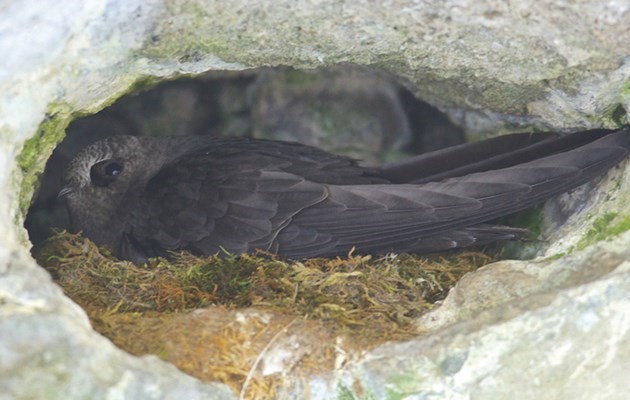BANFF – Hope is flying high for an endangered bird species in Banff National Park despite the birth of one less chick this year than last.
The colony at Johnston Canyon – the first inland nesting location identified for black swifts back in 1919 – was down from five to four successful nesting sites this year when only one of a mating pair returned from a winter in South America.
“That bird did stay at the nest for quite a while and then eventually left the nesting site when its mate didn’t return,” said Jen Reimer, a Parks Canada resource conservation officer who has been leading the black swift monitoring program in Banff National Park since 2015.
“We did initially have all five of those nests active that were active last year, but unfortunately, because only one bird returned, there was no egg laid so that nest is not active.”
Researchers can’t answer with certainty why one bird in a mating pair did not return this spring with the rest of the black swifts.
The birds are only monitored at their nesting site in Johnston Canyon and are not fitted with tracking tags to monitor migration to and from South America where they winter.
“It’s such a precarious time for birds when they’re migrating and lots of unfortunate things can happen,” said Reimer.
“Whether it was a natural mortality or something happened during migration or on their wintering grounds, we just don’t know.”
However, Reimer said this particular nest where only one adult returned is one of the longest standing active nests in Johnston Canyon.
“Last year, the birds appeared to be one of the older pairs – that’s only a suspicion, there’s no evidence of that – but they seemed to be a well established pair,” she said.
The black swift, recognized by its black plumage, long and pointed wings and unique notched tail, is the largest swift in North America.
Although little is known about the biology of the species, it’s believed the birds live upwards of 16 years of age and may mate for life.
Black swifts also only lay one egg a season and have a lengthy seven-week rearing period, with chicks not fledging until September.
The nesting duties are shared by the parents, with both the male and female trading off on shifts during the incubation period.
Reimer said there is a chick in all four of the active nests at Johnston Canyon, all at varying levels of development.
She said there was a range in the fledging dates last year between Sept. 8 and Sept.18 – so she expects the same again this year based on how the chicks’ flight feathers are growing in.
“When they first hatch they just have downy plumage and then they eventually molt into their first adult plumage,” said Reimer.
“We can see the various stages of those flight feathers, that they will need to leave the nests with, are starting to grow in.”
Last year, five active black swift nests were confirmed in Johnston Canyon – the highest number of active nests recorded in the canyon since 2004.
In 2020, three nesting pairs were spotted, while only one or two active nests were recorded between 2005 and 2019.
Today, the numbers are still below historical numbers of up to 12 active nests in the 1970s and early 1980s.
But Parks Canada is making the species comeback a top priority.
“I would say we’re quite pleased that we’ve had two years in a row of five nesting attempts,” Reimer said.
“Having five nests right now is an indication that the colony, at least right now, is temporarily stable.”
In 2019, the black swift was designated as an endangered species under Canada’s Species at Risk Act. It is estimated black swifts have faced a 50 per cent decrease in population since 1973.
Johnston Canyon provides critical nesting habitat for the birds and is one of only two known nesting areas in Banff National Park. The other one is in the backcountry near Egypt Lake.
Due to the sensitive nature of black swift nesting, Parks Canada has implemented an off-trail restriction at Johnston Canyon from May 1 to Nov. 15 and is currently building a new guard rail, in part, to help discourage people from going off-trail.
“They need the space and security to nest without disruption,” said Reimer.
Researchers continue to use different tools to study black swifts, including thermal imaging cameras to locate and monitor nests, time-lapse remote cameras to reveal bird activity patterns and temperature and humidity sensors to help understand this species’ micro-climate needs.
This summer and next summer, researchers are also collecting bird poop for DNA meta-barcoding to learn about what the black swifts are eating here; it’s a species that specializes on a diet of flying insects.
“We’re trying to use the most non-invasive techniques that we can so we can collect information without disturbing the birds,” said Reimer.
Research being undertaken and information collected on the black swifts will help form part of a legally-required recovery strategy for the at-risk birds.
Reimer said the strategy is behind schedule, but feels it will be a superior document as a result of all the work being done.
“I think we’ll have a stronger document with better information on critical habitat,” she said.
If you witness anyone disturbing a black swift or its nest, observe, record and report this information to Banff emergency dispatch 403-762-1470, anytime day or night.




